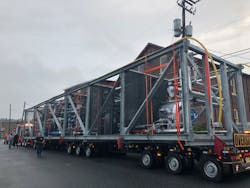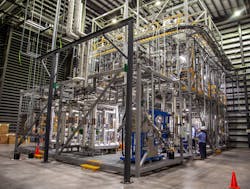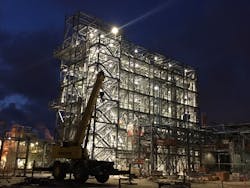Truckable modules paving the road for advantageous construction solutions
Modularization has been around since the early 1970’s. The technique allows owners to transfer much of the construction from remote field locations to established fabrication yards, where labor is available. This results in higher productivity. Inherent benefits of this strategy not only improved quality and safety but also improved cost and schedules by mitigating many of the related risks associated with construction in remote or hostile environments.
These techniques slowly made their way into the remote areas of West Texas and the Bakken region. Today, modularization has become commonplace, regardless of location, as a key component to optimize a project’s construction execution phase. What once required an education of the client on modularization, has now become more of a discussion on how much of a project can be modularized versus field constructed.
Now, modular construction has evolved to a point where complete process systems can be prefabricated at an offsite module assembly facility to the maximum extent possible. In general, as much as 90% of construction can be transferred from the field to the module assembly facility thus mitigating inherent risks associated with field construction.
Overall benefits of modularization versus field construction are well known and include:
- Reduced number of onsite field laborers
- Improved quality
- Increased productivity
- Reduced health and safety risk exposure to the construction workforce
- Minimized interruption to site operations
- Improved schedule
- Construction occurs at module assembly shop in parallel with permitting, civil works and other critical path activities, significantly improving time to market for customer’s products.
Advantaged module solutions
When evaluating modularization as an execution strategy, an often-overlooked module type are truckable modules. Unlike traditional modules, which can weigh anywhere from 500 tons to more than 6,000 tons and require transportation by rail or barge, truckable modules can be moved across standard roadways. Many project managers who thought they could not employ a modularization strategy because of their projects’ distance from waterways can now leverage the benefits of modularization by employing a truckable module strategy.
Truckable modules are advantaged by their easily manageable dimensions, which typically have a footprint of 12 feet by 14 feet and can reach a length on the truck of around 90 feet. The modules can either be installed in the horizontal or vertical orientation once erected in the field. For distillation column applications, where the column height exceeds the overall erected height of a given module, the column can either be dropped into the module or flanged together at site, or two vertically oriented modules can be bolted together. Additionally, where process systems require multiple modules to form a complete operating process system, these modules can be interconnected both horizontally and vertically, likeLEGO pieces.
Truckable modules are further advantaged in that due to their relative size. They are typically assembled indoors in an assembly-line fashion versus outside at a fabrication yard. The completed modules include the necessary columns, reactors, vessels, heat exchangers, pumps, filters and other equipment plus all process and utility piping. They also include all field instrumentation pre-wired to instrument junction boxes or control panels, plus heat tracing, thermal insulation, lighting, control systems, safety showers and fire protection piping, all installed within a structural steel frame. These frames serve as support during shipment and provide access to the equipment for operation and maintenance after installation at the project site. Upon completion, a rigorous factory acceptance testing program is conducted on all these components before shipping to the field.
Truckable modules may not be applicable to all projects due to the maximum sizes imposed by roadway transportation. However, by performing a comprehensive modularization study, unit operations can be optimized where possible to fit within the truckable module envelope. Where columns, vessels and other equipment do not fit within the module, those pieces can be shipped separately and installed freestanding alongside modules that house the balance of the system.
Benefits of truckable modules over traditional modules
Aside from opening modularization as an option to inland projects, truckable modules offer unique benefits to all projects including those with barge access who may historically opt for a traditional module execution strategy.
Those benefits include:
- Access to a broader network of module fabricators: Due to their specialized nature in size and weight, traditional modules require specialized module fabrication yards. These yards are typically located in the gulf coast or in lower cost international regions. However, a truckable module assembly shop does not need the same specialized equipment nor does it need to be near a project location. By not being geographically tied to the project or not requiring specialized fabrication yards, the project can expand its supply chain to include smaller, more competitive engineering firms who execute projects using a truckable module project delivery model, as well as leverage lower cost regions of the United States.
- Access to a broader available skilled labor pool: Given the traditional modular fabrication yards proximity to industrial regions within the gulf coast, they tend to compete for local skilled labor resources. Therefore, during active markets, projects are impacted by an increase in module fabrication costs due in part to a competitive labor market. Again, should the project expand its supply chain to include smaller, more competitive engineering firms who execute projects using a truckable module project delivery model, fabrication can be transferred to regions not impacted by the project regions active market. Additionally, in cases where a project required expertise is in short supply in the project region, truckable modules allow for fabrication in regions where such expertise may be readily available.
- Indoor controlled module assembly: Truckable modules provide for additional productivity, quality and safety benefits obtained through modularization beyond levels experienced by traditional modules. Due to the typical dimensions of truckable modules, they can be assembled indoors within a controlled environment and unaffected by inclement weather. At an indoor modular assembly shop, assembly is performed in a step-by-step, assembly line style of construction, which allows for predictable procedures and improves overall product quality. Given these modules are assembled in the horizontal orientation, typically workers are not exposed to working at height, thus further reducing the risk of injury to personnel.
- Fabrication Availability: When markets get hot, lead times increase due to the volume of work. Again, by opening your supply chain to include truckable module fabricators, regions with excess fabrication capacity can be leveraged to stay on schedule, as well as reduce time to market. Once fabricators receive a process design packake,truckable module projects can be designed, engineered, fabricated and delivered on site as short as 8 to 9 months or within 14 to 18 months for large multi-module projects.
- Minimized impact to site operations: As with traditional modules, using truckable modules minimizes the impact to site operations by transferring much of the associated construction activities to an offsite facility. However, where truckable modules differentiate themselves from traditional modules is by reducing the complexity of module installation within a brownfield site. Due to the relatively smaller dimensions and weight of each module, site access is less restricted and typically does not require specialized cranes and other lifting equipment.
- Reduced transportation cost: Due to the logistical challenges and need for specialized handing equipment related to transporting traditional modules, truckable module transportation costs are a fraction of traditional modules.
- Overall cost savings: Depending on the type of traditional modules employed and the location of fabrication, truckable modules can result in an overall cost savings over traditional module construction.
Truckable modules as a pathway from concept to commercialization
Truckable modules that are well suited to support various stages of project development and the commercialization of novel technology. Pilot or demonstration scale systems lend themselves very well to be designed and constructed using a truckable module execution strategy. For example, when plastics recycling company PureCycle pursued the development of their advanced recycling technology, they opted to construct their Phase I Feedstock Evaluation Unit as a truckable module system. Their process, which removes color, odor and other contaminants from recycled feedstock, results in virgin-like ultra-pure recycled polypropylene. Their commercial scale system is also designed and constructed as a truckable module system.
As we begin to exit this period of lower activity resulting from COVID, project activity is expected to rebound. This resurgence of project activity will undoubtedly result in a competitive market to secure fabrication yard capacity as well as stretch regional skilled craft labor forces. As a strategy to mitigate project cost escalation, ensure skilled craft labor availability and ultimately achieve time to market as soon as possible coming out of COVID, truckable modules are an alternative construction execution strategy worth considering.
Mauricio Villegas is the manager of business development at Koch Modular Process Systems. He has more than 25 years of experience in the engineering and construction industry, delivering projects across industries ranging from small brownfield projects to greenfield mega-projects. Prior to joining Koch Modular, he held various management roles at WorleyParsons, Technip, IHI E&C and Arcadis. Villegas earned a bachelor’s degree in business administration and management from Northeastern University.
Tom Shafer is vice president of Koch Modular and has more than 40 years’ experience in the process design, operations management, cost estimating, plant layout, and sales & marketing. Specific expertise in equipment design, including distillation, heat transfer, fluid flow, and process control. Shafer holds a bachelor’s degree in chemical engineering and a master’s in chemical engineering from Manhattan College.
About the Author
Mauricio Villegas
manager of business development at Koch Modular Process Systems
Mauricio Villegas is the manager of business development at Koch Modular Process Systems. He has more than 25 years of experience in the engineering and construction industry, delivering projects across industries ranging from small brownfield projects to greenfield mega-projects. Prior to joining Koch Modular, he held various management roles at WorleyParsons, Technip, IHI E&C and Arcadis. Villegas earned a bachelor’s degree in business administration and management from Northeastern University.
Tom Shafer
vice president of Koch Modular Process Systems
Tom Shafer is vice president of Koch Modular and has more than 40 years’ experience in the process design, operations management, cost estimating, plant layout, and sales & marketing. Specific expertise in equipment design, including distillation, heat transfer, fluid flow, and process control. Shafer holds a bachelor’s degree in chemical engineering and a master’s in chemical engineering from Manhattan College.


